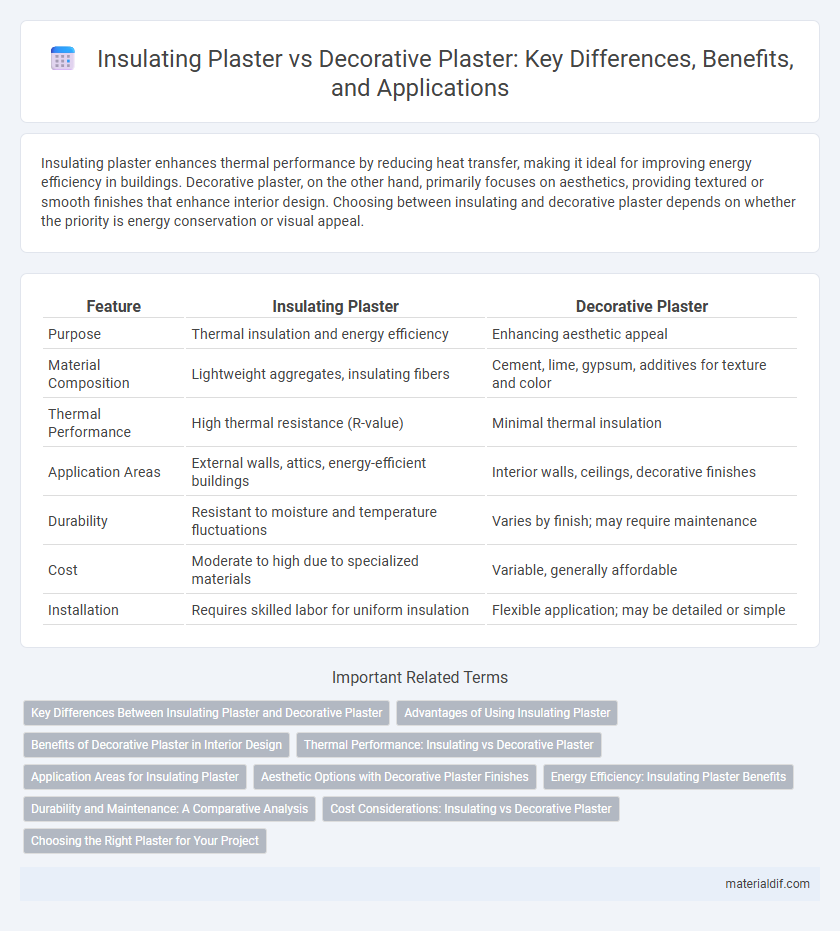Insulating plaster enhances thermal performance by reducing heat transfer, making it ideal for improving energy efficiency in buildings. Decorative plaster, on the other hand, primarily focuses on aesthetics, providing textured or smooth finishes that enhance interior design. Choosing between insulating and decorative plaster depends on whether the priority is energy conservation or visual appeal.
Table of Comparison
| Feature | Insulating Plaster | Decorative Plaster |
|---|---|---|
| Purpose | Thermal insulation and energy efficiency | Enhancing aesthetic appeal |
| Material Composition | Lightweight aggregates, insulating fibers | Cement, lime, gypsum, additives for texture and color |
| Thermal Performance | High thermal resistance (R-value) | Minimal thermal insulation |
| Application Areas | External walls, attics, energy-efficient buildings | Interior walls, ceilings, decorative finishes |
| Durability | Resistant to moisture and temperature fluctuations | Varies by finish; may require maintenance |
| Cost | Moderate to high due to specialized materials | Variable, generally affordable |
| Installation | Requires skilled labor for uniform insulation | Flexible application; may be detailed or simple |
Key Differences Between Insulating Plaster and Decorative Plaster
Insulating plaster primarily enhances thermal efficiency by reducing heat loss, whereas decorative plaster focuses on aesthetic appeal and surface texture. Insulating plaster contains materials like expanded perlite or vermiculite to improve energy conservation, while decorative plaster uses gypsum or lime for smooth or textured finishes. The key differences lie in functional performance, material composition, and end-use objectives, with insulating plaster aimed at energy savings and decorative plaster designed to enhance interior or exterior design.
Advantages of Using Insulating Plaster
Insulating plaster significantly improves building energy efficiency by reducing heat loss through walls, leading to lower heating and cooling costs. It also enhances indoor comfort by maintaining stable temperatures and minimizing condensation and mold growth. Compared to decorative plaster, insulating plaster offers functional thermal benefits while still providing a smooth surface suitable for further finishing.
Benefits of Decorative Plaster in Interior Design
Decorative plaster enhances interior design by providing textured finishes and customized patterns that elevate aesthetic appeal while offering durability. Its moisture-resistant properties contribute to improved wall longevity and reduced maintenance costs. The versatility of decorative plaster allows for creative expression, harmonizing with various styles and complementing architectural features effectively.
Thermal Performance: Insulating vs Decorative Plaster
Insulating plaster improves thermal performance by reducing heat transfer, maintaining indoor temperature, and enhancing energy efficiency in buildings. Decorative plaster primarily focuses on aesthetics, offering textured finishes without significant insulation properties. Choosing insulating plaster supports lower heating and cooling costs, whereas decorative plaster prioritizes visual appeal over thermal benefits.
Application Areas for Insulating Plaster
Insulating plaster is primarily applied in construction and renovation projects aiming to enhance thermal efficiency, often used on exterior walls, lofts, and basements to reduce heat loss and improve energy savings. It is ideal for both residential and commercial buildings requiring improved insulation without compromising structural integrity. Unlike decorative plaster, which focuses on aesthetic finishes inside spaces such as ceilings and feature walls, insulating plaster serves a functional role in climate control and moisture regulation.
Aesthetic Options with Decorative Plaster Finishes
Decorative plaster offers a wide range of aesthetic options, including textured, polished, and Venetian finishes that enhance interior design with elegance and artistic appeal. Unlike insulating plaster, which prioritizes thermal performance, decorative plaster emphasizes visual impact and customization through color, pattern, and surface effects. These finishes provide versatile solutions for both modern and traditional spaces, allowing architects and designers to create unique, visually striking environments.
Energy Efficiency: Insulating Plaster Benefits
Insulating plaster significantly improves energy efficiency by reducing heat loss through walls, leading to lower heating and cooling costs. Unlike decorative plaster, which primarily enhances aesthetic appeal, insulating plaster contains thermal-resistant materials such as perlite or expanded polystyrene that create a barrier against temperature fluctuations. This thermal insulation property contributes to better indoor climate control and increased sustainability in building design.
Durability and Maintenance: A Comparative Analysis
Insulating plaster offers superior durability by providing enhanced thermal resistance and moisture control, reducing the risk of cracks and structural damage over time compared to decorative plaster. Decorative plaster, while aesthetically pleasing with intricate textures and finishes, typically requires more frequent maintenance and touch-ups to prevent surface wear and discoloration. Choosing insulating plaster ensures a longer-lasting, low-maintenance wall solution, especially in environments with fluctuating temperatures and humidity.
Cost Considerations: Insulating vs Decorative Plaster
Insulating plaster often incurs higher upfront costs due to specialized materials like thermal additives and enhanced thickness requirements, which improve energy efficiency and reduce long-term heating expenses. Decorative plaster typically has lower initial expenses, focusing on aesthetic finishes and textures without insulation properties, making it more affordable for purely design-driven projects. Cost considerations should weigh immediate budget constraints against potential energy savings and the desired balance between functionality and visual appeal.
Choosing the Right Plaster for Your Project
Insulating plaster enhances energy efficiency by providing superior thermal resistance, ideal for projects prioritizing temperature regulation and energy savings. Decorative plaster offers aesthetic appeal with versatile textures and finishes, making it perfect for enhancing interior design and architectural details. Selecting the right plaster depends on balancing functional insulation needs against visual style preferences to achieve optimal performance and appearance.
Insulating Plaster vs Decorative Plaster Infographic

 materialdif.com
materialdif.com